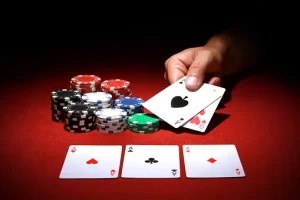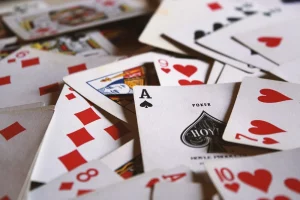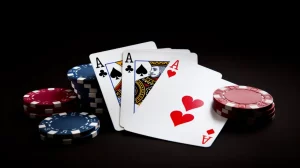What is Razz Poker
Razz is a poker game characterized by intriguing rules and dynamic gameplay. Unlike traditional poker, Razz is played with the goal of getting the lowest possible hand rather than the highest. This distinctive feature gives the game a high level of strategy and complexity, making it an exciting option for poker enthusiasts looking for a new challenge.
In Razz, which is usually played between 2 and 8 players, the goal is to form the lowest denomination hand using five cards out of the seven dealt. Although the rules of Razz replicate the basic structure of Seven Card Stud, where players are dealt a mixture of face-up and face-down cards over several rounds of betting, the winning hand is determined by the smallest combination of cards.
This inversion of traditional poker challenges, where the lowest hand wins, creates dynamic and exciting gameplay. Players must carefully strategize their card selection and betting strategies, trying to build the weakest possible hand while beating their opponents.
How to Play Razz Poker
Razz is a fascinating variation of poker that may seem a bit unfamiliar at first, but fear not, its rules are not too complicated. What’s more, its unique features add an exciting experience to the traditional game, making it a favorite among poker enthusiasts looking for something fresh and different.

At its core, Razz follows the same basic principles as other forms of poker but with a significant twist, instead of aiming for the highest hand, players compete to create the lowest possible hand. This means that traditional high hands such as flush and straight don’t carry much weight in Razz, while low-rated hands such as pair and set are considered strong.
The gameplay in Razz unfolds in much the same way as in other varieties of poker. It usually begins with each player placing a bet, depositing a small amount of chips into the pot to start the game. The dealer then deals each player three cards: two face down (hole cards) and one face up (door card). The player with the highest door card usually must make a “bring-in” bet, a mandatory bet to start the game.
Once the bring-in bet is made, the action moves clockwise around the table and players have the option to call (equalize the current bet), raise (increase the bet) or fold (reset the hand and lose any chips they have already invested). This continues in subsequent betting rounds as more cards are dealt and revealed.
Now let’s talk about “streets.” In Razz, gameplay is divided into streets, each consisting of a betting round followed by the dealing of additional cards. Streets are named after the number of cards dealt in that round. For example, after the first deal of three cards (known as the third street), there is a fourth street, a fifth street, a sixth street, and finally a seventh street.
As each street is passed, players are dealt additional cards face up, giving them more information to assess the strength of their hand and adjust their bets accordingly. The betting action continues until the last round is completed, usually after seventh street.
Throughout the game, players strive to assemble as low a hand as possible using five of their seven cards. Aces in Razz are always low, and flushes and straights do not count for a low hand. Thus, the ideal hand in Razz would be A-2-3-4-5, also known as a “wheel” or “bicycle”.
After the last round of betting is complete, players reveal their hands and the player with the lowest hand wins the pot. It is worth noting that draws are possible in Razz, in which case the pot is split equally between the players who drew.
Ante in Razz Poker
In poker, an ante is a small bet that each player must deposit into the pot before the cards are dealt. The ante serves several important purposes in the game:
Building the pot: By requiring each player to deposit a small amount into the pot before the hand begins, the ante helps ensure that there is always some money at stake, which makes the game more interesting and gives players an incentive to play every hand.
Action Encouragement: Because players are putting money into the pot from the start, they are less likely to immediately fold, which can lead to more action and excitement in the game.
Let’s understand how the ante works with a simple example:
Imagine you are playing a friendly game of poker with four other players. Before the cards are dealt, the dealer announces that the ante is $1. This means that each player must contribute $1 to the pot, resulting in a starting pot of $5 (including the dealer).
Now that the pot is formed, the dealer deals each player their hole cards (cards that only they can see). After everyone looks at their cards, the betting begins.
But wait, what about the bring-in you mentioned earlier? In some varieties of poker, such as razz, a special forced bet known as a bring-in is made instead of an ante.
At its core, the bring-in is similar to the ante in that it is a compulsory bet that helps start the betting action and ensures that there is something in the pot to play for. However, unlike the ante, which is usually a fixed amount paid by each player, the value of the raise is determined based on the value of the players’ door cards (the face-up cards that each player receives in the initial deal).
In Razz, for example, the player with the highest card is usually required to make a bring-in bet, which is usually a fraction of the lower limit bet. This bet acts as the opening bet, signaling the start of the betting action for that hand.
Razz Poker Hand Rankings
Understanding poker hands is crucial in any variant of the game, including Razz. Knowing the strength of your hand and how it compares to your opponents’ hands is essential to making informed betting decisions and ultimately winning the pot. Let’s take a look at the different hands in Razz, starting with the strongest and ending with the weakest:
- Five-low (Wheel or Bicycle):
The best possible hand in Razz is Five-Low, also known as a wheel or bicycle. This hand consists of A-2-3-4-5, with the Ace acting as the low card. Since the goal of Razz is to play as low a hand as possible, having a wheel guarantees a win unless the other player also has a Five-Low.
Example: A♠-2♦-3♣-4♠-5♥
- Six-low:
The next best hand after the five-low is the six-low. This hand includes any five cards, the highest of which is a six or lower. The six-low is stronger than the seven-low because it has a lower senior card.
Example: 2♠-3♦-4♣-5♠-6♥
- Seven-low:
A seven-low consists of any five cards, with the highest card being a seven. Although it is not as strong as a five-low or six-low, a seven-low is still a decent hand in Razz.
Example: A♠-2♦-3♣-4♠-7♥
- Eight-low:
An eight-low includes any five cards whose highest card is an eight. Although eight-low is still a low hand, it is weaker than low hands such as five-low, six-low, and seven-low.
Example: 3♠-4♦-5♣-6♠-8♥
- Nine-low:
A nine-low consists of any five cards whose highest card is a nine. Although a nine-low is still a low hand, it is weaker than low hands such as five-low, six-low, seven-low, and eight-low.
Example: 4♠-5♦-6♣-7♠-9♥
- Ten-low or higher:
Any hand in Razz with a senior card of ten or higher is generally considered weak. The strength of these hands decreases as the value of the senior card increases.
Example: 5♠-6♦-7♣-8♠-10♥
In Razz, the goal is to make up as low a hand as possible using five of the seven cards. Remember that aces are always low, and flushes and straights do not count for a low hand. So while high ranking hands such as flushes and straights are strong in other varieties of poker, they are irrelevant in Razz.
What is a Showdown in Razz Poker

During showdown, players lay their cards face up on the table so that everyone can evaluate the strength of each hand. The player with the lowest hand wins the pot, taking home all the chips that were staked throughout the game.
Determining the winner of the Razz is easy, but it requires an understanding of the hand rankings. As mentioned, the goal of playing Razz is to assemble as low a hand as possible using five of the seven cards. Aces are always low, and flushes and straights do not count in determining the strength of a hand.
Let’s say Player A shows his hand: 5-4-3-3-2-2-2-A (suits are irrelevant in determining hand strength). At first glance, this hand may seem unusual, but in Razz it is the best possible hand. The Ace acts as the low card, and the 5-4-3-3-2-2-A sequence forms a perfect five-low, also known as a wheel or bicycle. Since Razz is a type of lowball, this hand is unbeatable and guarantees Player A a showdown victory.
It is important to note that while other varieties of poker prioritize high-ranking hands such as flush and straight, these hands do not matter in Razz. Instead, players focus on building as low a hand as possible to ensure they win the showdown.
Razz Poker Strategy
In Razz poker, strategies are essential to success at the tables. Let’s delve into each of the strategies described earlier to get a full understanding of how to play Razz effectively:
- Starting Hand Selection
Choosing the right starting hands sets the stage for a successful game of Razz. The goal of Razz is to play as low a hand as possible, so starting with low rank cards gives you a significant advantage. Look for hands with cards ranked 8 or lower, as they provide the best opportunity to build strong low hands. Hands with no pairs and the potential to form a low straight, such as A-2-, are especially valuable.
However, be careful with starting hands with high rank cards, as they can reduce your chances of forming a competitive low hand.
- Pay attention to open cards
Keeping an eye on the open cards on the table is very important for making informed decisions in Razz. By observing the cards that have been dealt to your opponents and the cards that have been discarded, you can gain valuable information about the distribution of cards remaining in the deck. This information will allow you to assess the likelihood of improving your hand and adjust your strategy accordingly. In addition, paying attention to the exposed cards can help you identify potential draw opportunities or assess the strength of your opponents’ hands.
- Table Position

Table position is a key factor in determining your strategic options in Razz. Playing in late position gives you a significant advantage because you have more information about your opponents’ actions before making your own decisions. This allows you to more accurately assess the strength of your hand in relation to your opponents’ hands and adjust your betting and exchange strategies accordingly. Conversely, playing in early position requires more caution because you have less information about the actions of players who act after you.
- Read your opponents
Understanding your opponents’ playing style is essential to gaining an advantage in Razz Poker. Pay attention to how your opponents bet, raise and react to different situations throughout the game. Look for patterns and trends that can indicate whether they are playing aggressively, passively, or bluffing frequently. By accurately reading your opponents, you will be able to strategize to exploit their weaknesses and capitalize on their mistakes.
- Bluffing and semi-bluffing
Bluffing can be a powerful tool in Razz, but it requires careful timing and execution. Bluffing involves presenting a stronger hand than you actually have in order to deceive your opponents and win the pot. However, bluffing in Razz requires a thorough understanding of hand rankings and betting patterns, as well as the ability to assess the likelihood that your opponents will fold. Also, consider semi-bluffing when you already have a decent hand but are looking to improve it by drawing additional cards. A semi-bluff can add an element of deception to your gameplay and increase your chances of success.
- Bankroll Management
Effective bankroll management is crucial for long-term success in Razz poker. It is important to set a budget for your poker game and stick to it, whether you are winning or losing. Avoid the temptation to chase losses or bet more than you can afford to lose. Instead, manage your bankroll wisely by making informed decisions about the size of your bets and the stakes you play. By being disciplined and careful with your bankroll, you will be able to continue to play and enjoy the game for a long time.
- Adapting to the dynamics of the game
Flexibility and adaptability are key qualities of successful Razz players. Be prepared to adjust your strategy depending on the dynamics of the game and the specific circumstances you face. This may include changing betting patterns, hand selection criteria, or your approach to bluffing and semi-bluffing. By staying open to new information and adapting your strategy accordingly, you can maximize your chances of success in any game of Razz poker.
- Patience
While it may be tempting to play every hand or chase marginal draws, exercising restraint and waiting for favorable opportunities can be beneficial in the long run. Don’t be afraid to fold if you have a weak hand or the odds are against you. Instead, take your time and wait for situations where you have a good chance of winning. By being patient and practicing discipline, you can avoid unnecessary losses and ensure your success in the long run.
- Understanding the math of the game
A solid understanding of the mathematical principles behind Razz poker is essential to making informed decisions at the tables. This includes understanding the probabilities and odds of certain hands being played, as well as calculating pot odds and expected value. By applying mathematical concepts to your decision-making process, you will be able to make more rational and strategic choices about when to continue playing, when to fold, and when to bet or raise. In addition, understanding the math of the game will help you anticipate your opponents’ actions and exploit their tendencies more effectively.

